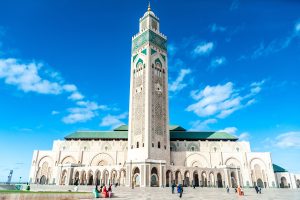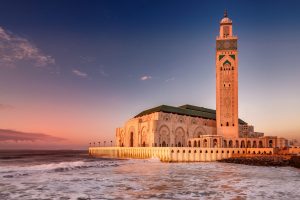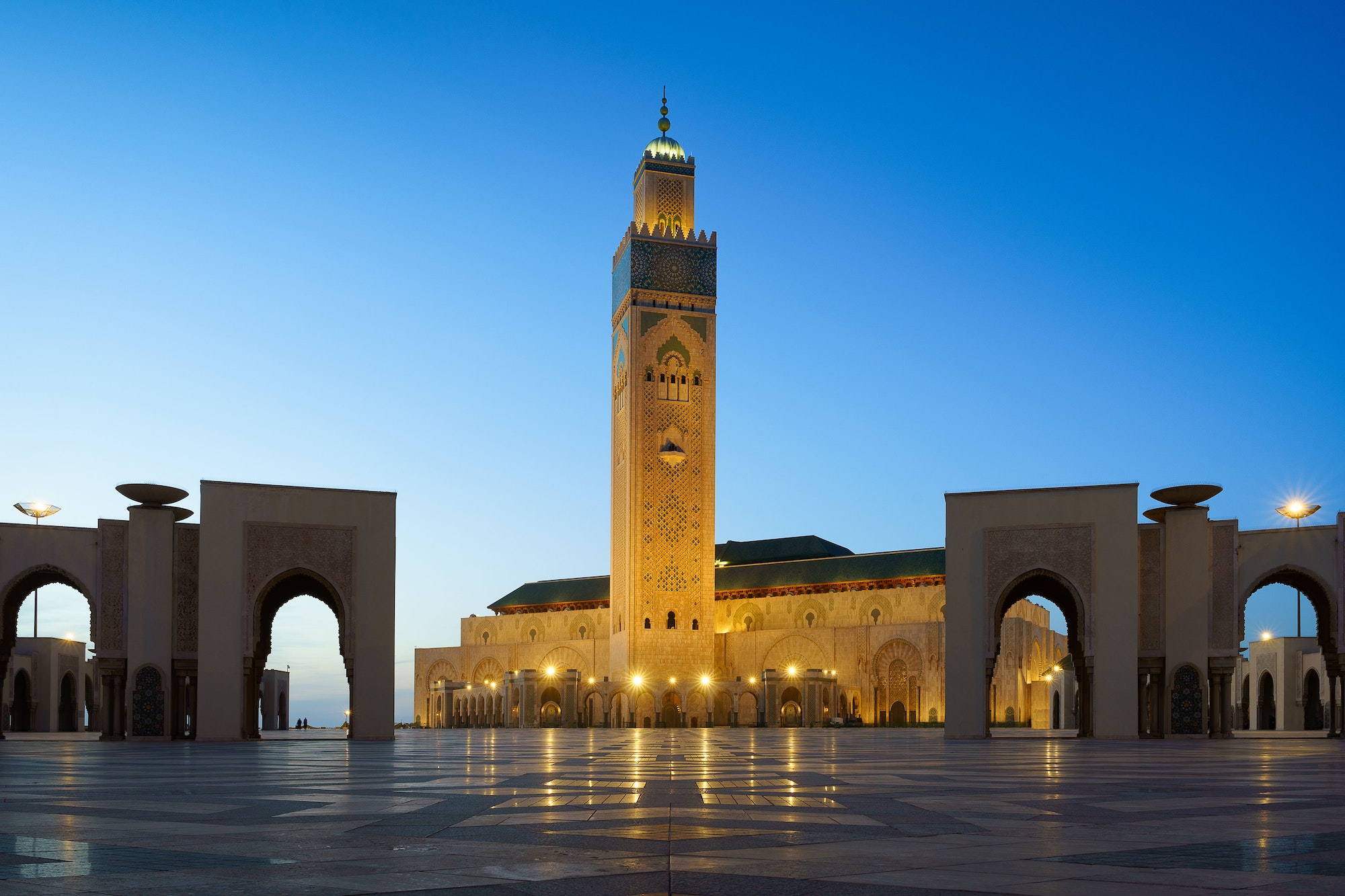Casablanca Morocco: largest city and a major economic hub. Known for its modern architecture and vibrant

culture, it features a mix of traditional Moroccan and contemporary influences. One of the city’s most famous landmarks is the Hassan II Mosque, which is one of the largest mosques in the world and has stunning oceanfront views.
The city also has a lively medina, beautiful beaches, and a burgeoning art scene. Casablanca is a melting pot of cultures, reflecting both its rich history and its position as a gateway between Africa and Europe. If you’re looking to explore, there are plenty of cafes, markets, and historical sites to discover!
Here are some more highlights and details about Casablanca:
Historical Background
Casablanca’s history dates back to the Phoenician era, but it really began to flourish during the French protectorate in the early 20th century. This period brought significant urban development, resulting in the city’s unique blend of Art Deco and Moorish architecture.
Key Attractions
Hassan II Mosque:
This architectural marvel can accommodate over 25,000 worshippers and features a stunning minaret that rises 210 meters. It’s one of the few mosques in Morocco open to non-Muslim visitors.
Old Medina:
While not as famous as the medinas in cities like Marrakech, Casablanca’s old town offers a charming mix of narrow streets, traditional shops, and local eateries.
Royal Palace of Casablanca:
Although not open to the public, the palace grounds are an impressive sight. It’s located in the Habous district, which is also known for its beautiful architecture and artisan shops.
Corniche:
This coastal promenade is perfect for a leisurely stroll, with stunning views of the Atlantic Ocean. It’s lined with restaurants, cafes, and beach clubs.
Anfa Place:
A modern shopping center and beach area, it’s a great spot for shopping, dining, and enjoying the seaside atmosphere.
Museum of Moroccan Judaism:
This unique museum offers insights into the history and culture of Morocco’s Jewish community, showcasing artifacts and exhibits that highlight their contributions to Moroccan society.
Culture and Cuisine
Casablanca’s culinary scene is vibrant, featuring a mix of traditional Moroccan dishes and international cuisine. Don’t miss trying tagine, couscous, and fresh seafood. The city also has a lively cafe culture, where you can enjoy mint tea or coffee while soaking in the local atmosphere.
Events and Festivals
Casablanca hosts various cultural events throughout the year, including the Casablanca Arts Festival and jazz concerts. The city’s nightlife is also lively, with plenty of bars, clubs, and live music venues.
Practical Tips
- Getting Around: The city has a public tram system that makes it easy to navigate. Taxis are also widely available.
- Language: Arabic and French are the most commonly spoken languages, so knowing a few basic phrases can be helpful.
- Best Time to Visit: The best time to visit is during spring (March to May) or fall (September to November) when the weather is mild.
Here’s a deeper dive into various aspects of Casablanca:
Architecture
- Art Deco Influence: The French colonial period left a significant Art Deco legacy in the city. Buildings like the Villa des Arts and the Cinelands showcase this architectural style, blending it with Moroccan elements.
- Habous Quarter: This neighborhood is characterized by its traditional Moroccan architecture, narrow alleys, and markets. It’s a great place to find local crafts, like pottery and textiles.
Markets and Shopping
- Central Market (Marché Central): A bustling market where you can find fresh produce, spices, and local delicacies. It’s a sensory experience, with vibrant colors and enticing aromas.
- Morocco Mall: One of Africa’s largest shopping centers, featuring international brands, a large food court, and even an aquarium. It’s a great place for a more modern shopping experience.
Cultural Experiences
- Cultural Center of Casablanca Morocco: This venue hosts various art exhibitions, performances, and workshops, providing insight into the local arts scene.
- Film Heritage: Casablanca is famous for the classic film “Casablanca” (1942). While the city doesn’t resemble the movie’s portrayal, it has embraced its cinematic legacy with events celebrating film and storytelling.
Outdoor Activities
- Beaches: The beaches along the Corniche are popular for sunbathing and water sports. You can also find beach clubs that offer amenities and entertainment.
- Parc de la Ligue Arabe: This large urban park is perfect for a relaxing stroll or a picnic. It features beautiful gardens, fountains, and shady spots to escape the sun.
Culinary Delights
- Street Food: Don’t miss trying street food like briouates (savory pastries), grilled fish, and seffa (sweet vermicelli topped with almonds and cinnamon). The street vendors provide a glimpse into local culinary traditions.
- Traditional Moroccan Restaurants: Experience a traditional Moroccan meal in a riad or restaurant, often served in a communal style with multiple courses.
Nightlife
- Clubs and Bars: Casablanca has a vibrant nightlife scene, with a mix of upscale clubs and laid-back bars. Places like Sky 28, located on the top floor of the Kenzi Tower Hotel, offer stunning views and a lively atmosphere.
- Live Music Venues: Enjoy jazz, rock, or traditional Moroccan music at venues around the city, reflecting the diverse musical heritage of Casablanca.
Festivals and Events
- Casablanca Morocco Music Festival: Celebrating various music genres, this festival attracts both local and international artists.
- Ramadan: If you visit during Ramadan, experiencing the iftar (breaking of the fast) in the evenings is a unique cultural experience, with communal meals and special dishes.
Transportation
- Tram System: The tram is a convenient way to navigate the city, connecting various neighborhoods and attractions.
- Taxis: Be sure to negotiate fares in advance if you’re not using a taxi meter. “Petit taxis” are great for short distances, while “grand taxis” are shared cabs for longer trips.
Safety Tips
- Casablanca is generally safe for tourists, but like any large city, it’s wise to stay vigilant, especially in crowded areas. Avoid displaying valuables and be cautious when navigating less crowded streets at night.
Here’s more about Casablanca Morocco, focusing on various themes and lesser-known aspects:
Historical Sites
- The Royal Palace: While access is limited, the area surrounding the Royal Palace in the Habous district is picturesque, with charming streets and local shops.
- Old Lighthouse of Casablanca: Located near the Hassan II Mosque, the old lighthouse is an interesting spot for photography, offering views of the coast.
Cultural Diversity
- Multicultural Influences: Casablanca is a melting pot of cultures, with influences from Berber, Arab, Jewish, and French traditions. This diversity is evident in the city’s cuisine, festivals, and everyday life.
- Street Art: The city has a burgeoning street art scene, with vibrant murals that reflect local culture, social issues, and artistic expression. Exploring neighborhoods like the Maarif district can reveal some striking pieces.
Nature and Parks
- Parc de la Ligue Arabe: This is one of the largest parks in Casablanca, perfect for walking, jogging, or relaxing under the trees. It’s a green oasis in the urban landscape, featuring a variety of plants and flowers.
- Phare d’El Hank: The El Hank Lighthouse, located in the coastal area, is a beautiful spot to watch the sunset and enjoy the ocean breeze.
Religious Sites
- Church of Notre-Dame de Lourdes: This modern church, known for its stunning stained-glass windows, represents the Christian community in Morocco and offers a different perspective on the country’s religious diversity.
- Zawiya of Moulay Idriss: A religious site dedicated to one of the founding figures of Morocco, this is a place of pilgrimage for many.
Local Experiences
- Cooking Classes: Participating in a cooking class can provide a deeper understanding of Moroccan cuisine. Learn how to prepare traditional dishes like tagine or pastilla.
- Traditional Hammams: Visiting a local hammam (public bath) is a unique cultural experience. It’s a great way to relax and enjoy a traditional Moroccan ritual of cleansing and rejuvenation.
Arts and Literature
- Literary Scene: Casablanca has inspired numerous writers and filmmakers. The city’s backdrop has influenced works by authors like Paul Bowles and has a vibrant community of local writers and poets.
- Art Galleries: Explore contemporary art galleries like the L’Atelier 21, which showcases local and international artists, offering a glimpse into Morocco’s modern artistic landscape.
Transportation Insights
- Public Buses: In addition to trams, Casablanca has a network of buses that can be useful for getting around. They are generally affordable and cover many parts of the city.
- Car Rentals: Renting a car can be a good option for those wanting to explore areas outside of Casablanca, but be aware that driving can be challenging due to traffic and local driving habits.
Sustainability Initiatives
- Green Spaces: There is a growing focus on creating more parks and green spaces in Casablanca to enhance urban living and environmental sustainability.
- Local Markets: Supporting local markets is encouraged to promote sustainable practices and help local artisans thrive.
Day Trips from Casablanca

- Rabat: Just an hour away by train, Morocco’s capital offers historical sites like the Kasbah of the Udayas, the Hassan Tower, and beautiful gardens.
- El Jadida: A coastal town about 90 minutes south, known for its Portuguese fortifications and beautiful beaches.
Tips for Travelers
- Cultural Etiquette: Dress modestly, especially when visiting religious sites. Being respectful of local customs and traditions goes a long way in ensuring a positive experience.
- Currency: The Moroccan Dirham (MAD) is the local currency. It’s helpful to have some cash for smaller purchases, though credit cards are widely accepted in larger establishments. More informasion: Merzougadeserttrips.com



